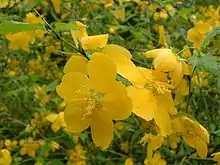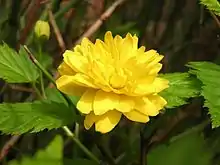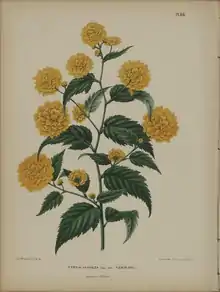Kerria japonica
Kerria japonica, also known as the Japanese marigold bush or miracle marigold bush in the northern New England area and as yamabuki (山吹) in Japan, is a deciduous shrub in the rose family Rosaceae, native to China, Japan and Korea. It is named after William Kerr, who introduced the cultivar 'Pleniflora'. It is the sole species in the genus Kerria; its genus name is also used as a common name (kerria).
| Kerria japonica | |
|---|---|
 | |
| Natural form | |
 | |
| Cultivar 'Pleniflora' | |
| Scientific classification | |
| Kingdom: | Plantae |
| Clade: | Tracheophytes |
| Clade: | Angiosperms |
| Clade: | Eudicots |
| Clade: | Rosids |
| Order: | Rosales |
| Family: | Rosaceae |
| Subfamily: | Amygdaloideae |
| Tribe: | Kerrieae |
| Genus: | Kerria DC. |
| Species: | K. japonica |
| Binomial name | |
| Kerria japonica | |

Description
Kerria japonica grows to 1–3 m (3.3–9.8 ft) tall, with weak arching stems often scrambling over other vegetation or rocks. In the wild it grows in thickets on mountain slopes. The leaves are alternate, simple, 3–10 cm long, with a doubly serrated margin. The flowers are golden yellow, with five petals, and evenly-spaced along branches of new green growth. The fruit is a dry single-seeded achene 4–4.5 mm long.[1]
Cultivation
Kerria is valued in gardens for its golden yellow flowers, which appear in the spring. It is best grown with some shade from full sunlight to avoid blanching the flowers, and needs to be pruned after flowering to maintain health and vigour.[2] Two cultivars have gained the Royal Horticultural Society's Award of Garden Merit, K. japonica 'Golden guinea'[3] and the double-flowered K. japonica 'Pleniflora', commonly known as bachelor's buttons.[4][5]
Pests and diseases
Since 2014 the UK's Royal Horticultural Society has been receiving reports from gardeners and horticulturalists of damage to plants of the shrub Kerria japonica. Symptoms include multiple red spots on leaves, and lesions on the stems, resulting in defoliation and eventual death. It has been determined that this infection is caused by the fungus Blumeriella kerriae, which is specific to the kerria. This highly contagious disease, known in English as kerria twig and leaf blight, was known in the U.S. but has not previously been observed on British plants. It is regarded as a serious threat to the cultivated kerria plants, which are popular garden shrubs.[6]
References
- Li Chao-luang, Hiroshi Ikeda & Hideaki Ohba. "Kerria japonica". Flora of China. Missouri Botanical Garden, St. Louis, MO & Harvard University Herbaria, Cambridge, MA. Retrieved 8 July 2012.
- "How to prune a Kerria japonica". SF Gate Homeguides. Retrieved 17 March 2018.
- "RHS Plant Selector - Kerria japonica 'Golden Guinea'". Royal Horticultural Society. Retrieved 27 September 2020.
- "RHS Plant Selector - Kerria japonica 'Pleniflora'". Royal Horticultural Society. Retrieved 27 September 2020.
- "AGM Plants - Ornamental" (PDF). Royal Horticultural Society. July 2017. p. 57. Retrieved 14 March 2018.
- "Kerria twig and leaf blight". Royal Horticultural Society. Retrieved 16 March 2018.
External links
 Media related to Kerria japonica at Wikimedia Commons
Media related to Kerria japonica at Wikimedia Commons Data related to Kerria at Wikispecies
Data related to Kerria at Wikispecies
